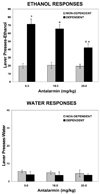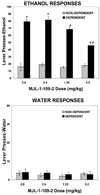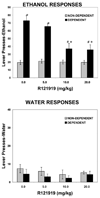Corticotropin-releasing factor 1 antagonists selectively reduce ethanol self-administration in ethanol-dependent rats
- PMID: 16876134
- PMCID: PMC2741496
- DOI: 10.1016/j.biopsych.2006.03.063
Corticotropin-releasing factor 1 antagonists selectively reduce ethanol self-administration in ethanol-dependent rats
Abstract
Background: Alcohol dependence is characterized by excessive alcohol consumption, loss of control over intake, and the presence of a withdrawal syndrome, which includes both motivational and physical symptoms. Similar to human alcoholics, ethanol-dependent animals display enhanced anxiety-like behaviors and enhanced ethanol self-administration during withdrawal, effects hypothesized to result from a dysregulation of corticotropin-releasing factor (CRF) stress systems. Here, we used an animal model of ethanol dependence to test the effects of CRF(1) receptor antagonists on excessive ethanol self-administration in dependent rats.
Methods: Wistar rats, trained to orally self-administer ethanol, were exposed intermittently to ethanol vapors to induce ethanol dependence. Nondependent animals were exposed to control air. Following a 2-hour period of withdrawal, dependent and nondependent animals were systemically administered antalarmin, MJL-1-109-2, or R121919 (CRF(1) antagonists) and ethanol self-administration was measured.
Results: The nonpeptide, small molecule CRF(1) antagonists selectively reduced excessive self-administration of ethanol in dependent animals during acute withdrawal. The antagonists had no effect on ethanol self-administration in nondependent rats.
Conclusions: These data demonstrate that CRF(1) receptors play an important role in mediating excessive ethanol self-administration in dependent rats, with no effect in nondependent rats. CRF(1) antagonists may be exciting new pharmacotherapeutic targets for the treatment of alcoholism in humans.
Figures




Similar articles
-
Corticotropin-releasing factor within the central nucleus of the amygdala mediates enhanced ethanol self-administration in withdrawn, ethanol-dependent rats.J Neurosci. 2006 Nov 1;26(44):11324-32. doi: 10.1523/JNEUROSCI.3096-06.2006. J Neurosci. 2006. PMID: 17079660 Free PMC article.
-
A CRF(2) agonist administered into the central nucleus of the amygdala decreases ethanol self-administration in ethanol-dependent rats.Brain Res. 2007 Jun 25;1155:172-8. doi: 10.1016/j.brainres.2007.04.009. Epub 2007 Apr 10. Brain Res. 2007. PMID: 17512918 Free PMC article.
-
MPZP: a novel small molecule corticotropin-releasing factor type 1 receptor (CRF1) antagonist.Pharmacol Biochem Behav. 2008 Feb;88(4):497-510. doi: 10.1016/j.pbb.2007.10.008. Epub 2007 Oct 23. Pharmacol Biochem Behav. 2008. PMID: 18031798 Free PMC article.
-
Operant alcohol self-administration in dependent rats: focus on the vapor model.Alcohol. 2014 May;48(3):277-86. doi: 10.1016/j.alcohol.2013.08.006. Epub 2013 Nov 1. Alcohol. 2014. PMID: 24290310 Free PMC article. Review.
-
Pre-clinical evidence that corticotropin-releasing factor (CRF) receptor antagonists are promising targets for pharmacological treatment of alcoholism.CNS Neurol Disord Drug Targets. 2010 Mar;9(1):77-86. doi: 10.2174/187152710790966605. CNS Neurol Disord Drug Targets. 2010. PMID: 20201818 Free PMC article. Review.
Cited by
-
Effects of alcohol dependence and withdrawal on stress responsiveness and alcohol consumption.Alcohol Res. 2012;34(4):448-58. Alcohol Res. 2012. PMID: 23584111 Free PMC article. Review.
-
The influence of stress on the transition from drug use to addiction.Alcohol Res Health. 2008;31(2):119-36. Alcohol Res Health. 2008. PMID: 23584814 Free PMC article. Review.
-
Corticotropin-releasing factor (CRF) and α 2 adrenergic receptors mediate heroin withdrawal-potentiated startle in rats.Int J Neuropsychopharmacol. 2013 Sep;16(8):1867-75. doi: 10.1017/S1461145713000308. Epub 2013 Apr 16. Int J Neuropsychopharmacol. 2013. PMID: 23590881 Free PMC article.
-
CRF modulation of central monoaminergic function: Implications for sex differences in alcohol drinking and anxiety.Alcohol. 2018 Nov;72:33-47. doi: 10.1016/j.alcohol.2018.01.007. Epub 2018 Feb 2. Alcohol. 2018. PMID: 30217435 Free PMC article. Review.
-
Chronic alcohol exposure differentially affects activation of female locus coeruleus neurons and the subcellular distribution of corticotropin releasing factor receptors.Prog Neuropsychopharmacol Biol Psychiatry. 2015 Jan 2;56:66-74. doi: 10.1016/j.pnpbp.2014.08.005. Epub 2014 Aug 20. Prog Neuropsychopharmacol Biol Psychiatry. 2015. PMID: 25149913 Free PMC article.
References
-
- Alheid GF, Heimer L. New perspectives in basal forebrain organization of special relevance for neuropsychiatric disorders: The striatopallidal, amgdaloid, and corticopetal components of substantia innominata. Neuroscience. 1995;27:1–39. - PubMed
-
- American Psychiatric Association. Diagnostic and Statistical Manual of Mental Disorders. 4th ed. Washington, DC: American Psychiatric Press, Inc; 1994.
-
- Baldwin HA, Rassnick S, Rivier J, Koob GF. CRF antagonist reverses the “anxiogenic” response to ethanol withdrawal in the rat. Psychopharmacology (Berl) 1991;103:227–232. - PubMed
-
- Bale TL, Contarino A, Smith GW, Chan R, Gold LH, Sawchenko PE, et al. Mice deficient for corticotropin-releasing hormone receptor-2 display anxiety-like behaviour and are hypersensitive to stress. Nat Genet. 2000;24:410–414. - PubMed
-
- Begleiter H, Porjesz B. Persistence of a “subacute withdrawal syndrome” following chronic ethanol intake. Drug Alcohol Depend. 1979;4:353–357. - PubMed
Publication types
MeSH terms
Substances
Grants and funding
LinkOut - more resources
Full Text Sources
Other Literature Sources
Medical

